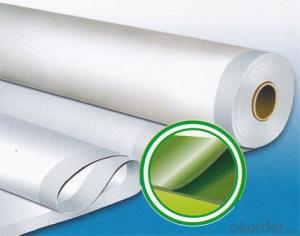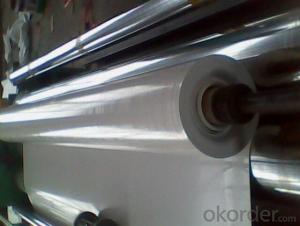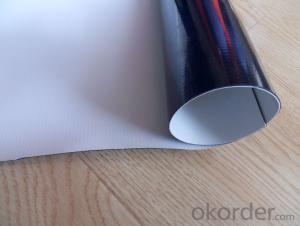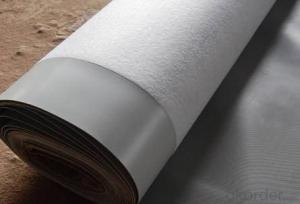PVC Waterproofing Membrane with Textile Materials
- Loading Port:
- Shanghai
- Payment Terms:
- TT OR LC
- Min Order Qty:
- 20000 m²
- Supply Capability:
- 5000000 m²/month
OKorder Service Pledge
OKorder Financial Service
You Might Also Like
PVC Waterproofing Membrane with Textile Materials
Product Description of PVC Waterproofing Membrane with Textile Materials:
PVC waterproofing membrane is an excellent high-quality polymer waterproof sheet, made of PVC resin by adding plasticizer, anti-UV agent, anti aging agent, and stabilizer and other processing aids through extrusion and molding. As the highly recommended product by the Ministry of Construction, it is featured by high tensile strength, great elongation, good stability, small shrinkage, low-temperature performances, good resistance to weathering and root
penetration, and long service life.
Features of PVC Waterproofing Membrane with Textile Materials:
1.Long service life and weathering resistance; and the materials can be used for 30 years on the roof and 50 years underground.
2. High tensile strength, great elongation, and small size change during heat treatment.
3. Good low temperature flexibility and adaptability to environmental temperature changes.
4. Good resistance to root penetration. It can be made for green roofs.
5. Excellent resistance to puncture and impact.
6. Convenient for construction (can be welded), solid and reliable, and Eco-friendly.
7. Strong resistance to chemical corrosion, suitable for special occasions.
8. Good plasticity, convenient and quick corner detail treatment. Easy maintenance and low cost.
9.After 2,000 hours of manual weathering verification
Classification of PVC Waterproofing Membrane with Textile Materials:
1. N: Homogeneous PVC membrane
2. L: PVC membrane with fabric backing
3. W: Reinforced PVC membrane
Advantage of PVC Waterproofing Membrane with Textile Materials:
1.) Mixing automation. Apply automatic temperature control automatic time control and automatic feed control.
2.) Extrusion equipment uses twin screw coextrusion. Screw temperature uses computer automatic temperature control system.
3.) Handpiece uses large width didhead extrusion equipment.
4.) Sophisticated three-roller calender equipment. The space between equiment is controlled by automation system.
Technical Data of PVC Waterproofing Membrane with Textile Materials:
No. | Item | Model Ⅱ | |
1 | Tensile Strength Mpa ≥ | 12.0 | |
2 | Elongation at break% ≥ | 250 | |
3 | Shrinkage rate % ≤ | 2.0 | |
4 | Flexibility at low temperature | No crackle at -25oC | |
5 | Water tightness | Watertight | |
6 | Puncture resistance | Watertight | |
7 | Heat aging treatment | Appearance | Free from bubble, crack, cohesion and void |
Change rate of tensile strength % | +20oC | ||
Change rate of elongation at break | |||
Flexibility at low temperature | No crack at -20oC | ||
8 | Chemical corrosion resistance | Change rate of tensile strength % | +20 |
Change rate of elongation at break | |||
Flexibility at low temperature | No crack at -20oC | ||
9 | Artificial weathering | Change rate of tensile strength % | +20 |
Change rate of elongation at break | |||
Flexibility at low temperature | No crack at -20oC | ||
Application of PVC Waterproofing Membrane with Textile Materials:
1) All kinds of roofs, such as steel structure roof, planted roof etc.
2) Underground engineering, such as building basement, subways, tunnels, air raid shelter, etc.
3) Other projects like artificial lake, dam, water reservoir, grain storehouse, etc.
Images of PVC Waterproofing Membrane with Textile Materials:
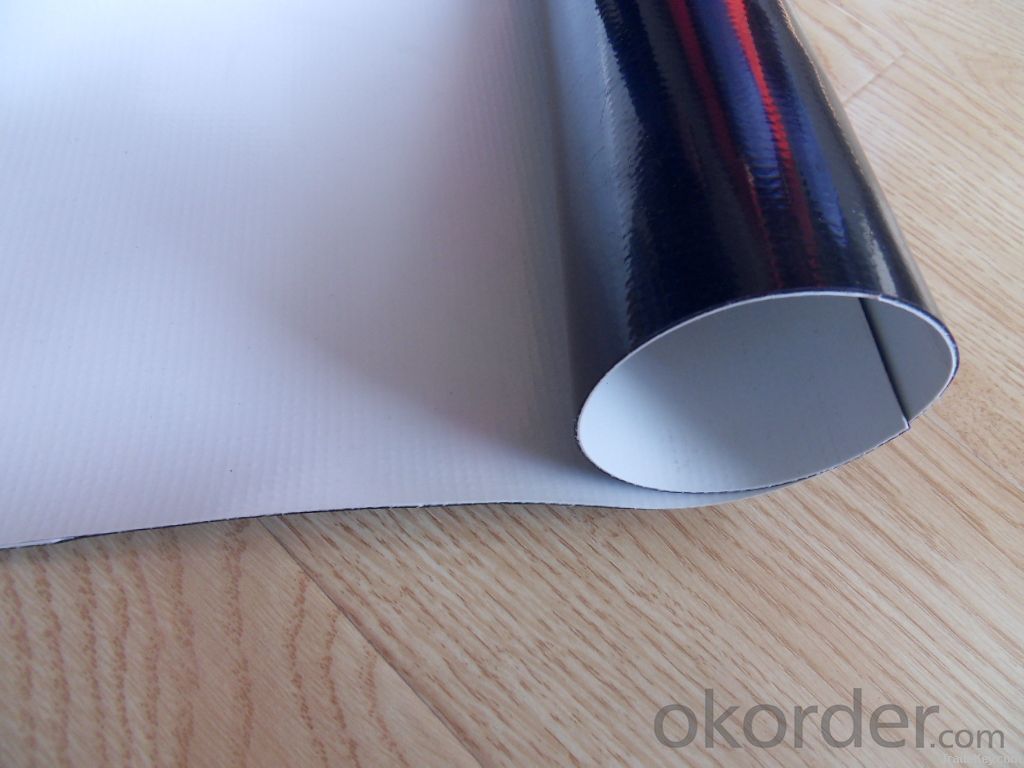
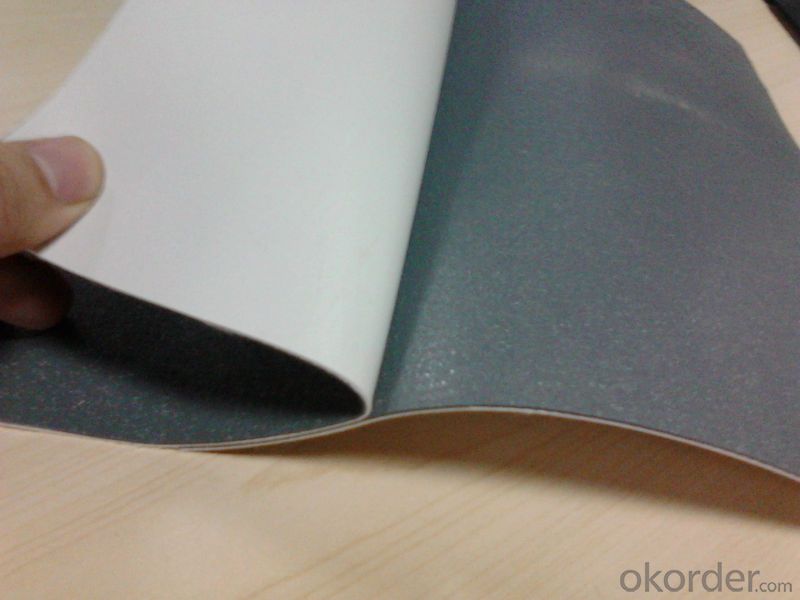
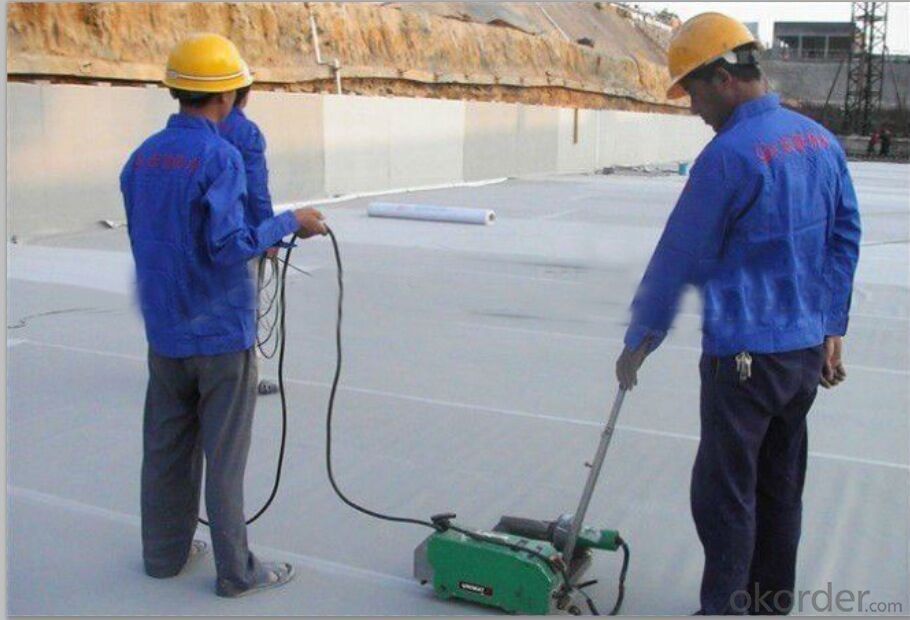

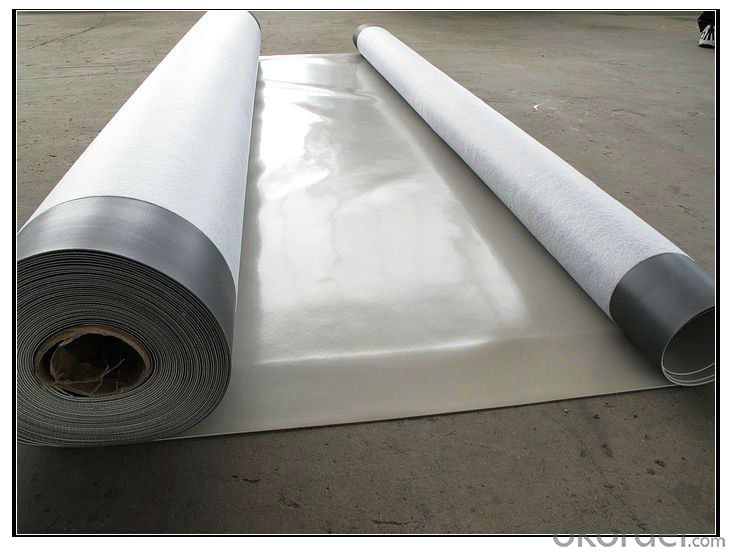
FAQ of PVC Waterproofing Membrane with Textile Materials:
1. Can you produce 4m width?
Yes, no problem for us. We have four bases in China, largest one in this field.
2. How many quantity in one 20'' container for 1.2mm and 1.5mm?
480rolls, 11520m2 for 1.2mm and 400rolls, 9600m2 for 1.5mm
3. Can you provide free samples?
Yes, our samples are free, but express fees usually on buyer's account.
- Q:Can waterproofing membranes be applied in cold weather?
- Yes, waterproofing membranes can be applied in cold weather. However, it is important to ensure that the manufacturer's instructions are followed regarding temperature limitations and proper installation techniques. Cold weather may affect the curing and adhesion process, so additional precautions and proper heating or insulation methods may be necessary during the application.
- Q:Can a waterproofing membrane withstand heavy rain or water pressure?
- Yes, a waterproofing membrane is designed to withstand heavy rain and high water pressure. It is specifically engineered to create a barrier that prevents water from penetrating through, ensuring the protection and integrity of the underlying structure.
- Q:Can a waterproofing membrane be used in areas with extreme weather conditions, such as hurricanes or snowstorms?
- Yes, a waterproofing membrane can be used in areas with extreme weather conditions, such as hurricanes or snowstorms. Waterproofing membranes are designed to provide a protective barrier against water infiltration and can effectively withstand various weather conditions. They are made from materials that are resistant to moisture and can be installed in different areas like roofs, basements, or foundations. In regions prone to hurricanes, waterproofing membranes can help prevent water damage by creating a barrier that keeps water out even during heavy rainfall or storm surges. These membranes are often reinforced and have high tensile strength to withstand the strong winds and pressure associated with hurricanes. Similarly, in areas with heavy snowstorms, waterproofing membranes can help prevent water intrusion caused by melting snow or ice dams. They are designed to be flexible and resistant to extreme temperatures, ensuring that they maintain their integrity and prevent leaks even in freezing conditions. However, it is important to choose the right type of waterproofing membrane suitable for the specific weather conditions in the area. Different membranes have varying levels of resistance to extreme weather, so it is advisable to consult with a professional to determine the most appropriate membrane for the specific climate and weather patterns. Additionally, proper installation and regular maintenance are crucial to ensure the longevity and effectiveness of the waterproofing system in extreme weather conditions.
- Q:Can waterproofing membranes be applied over existing surfaces?
- Yes, waterproofing membranes can be applied over existing surfaces. These membranes are designed to adhere to a variety of materials such as concrete, wood, metal, and more. However, it is important to ensure that the existing surface is clean, free of any loose materials or contaminants, and properly prepared before applying the waterproofing membrane for optimal results.
- Q:Can a waterproofing membrane be used for a parking lot?
- Indeed, a parking lot can benefit greatly from the utilization of a waterproofing membrane. Specifically engineered to create a safeguard against water infiltration, this remarkable membrane can be skillfully applied to a myriad of surfaces, encompassing parking lots. Its primary purpose is to thwart water-related damages, such as the formation of cracks and the degradation caused by the dreaded freeze-thaw cycles, ultimately leading to an elongated lifespan for the parking lot. Moreover, the implementation of a waterproofing membrane in a parking lot not only aids in the prevention of water leakage into the subbase, but it also fortifies its stability, effectively mitigating the possibility of exorbitant repairs. This intelligent investment not only bolsters the durability and longevity of the parking lot but also curtails the necessity for excessive maintenance efforts. In essence, the utilization of a waterproofing membrane for a parking lot serves as a prudent decision, ensuring enhanced endurance and reduced upkeep requirements.
- Q:Does a waterproofing membrane prevent efflorescence or mineral deposits on surfaces?
- Efflorescence or mineral deposits on surfaces can be prevented with the use of a waterproofing membrane. Efflorescence occurs when water-soluble salts dissolve in concrete or masonry materials and migrate to the surface, leaving behind a white residue. By stopping water from penetrating the surface, a waterproofing membrane reduces the amount of water available to dissolve these salts and carry them to the surface, effectively reducing the occurrence of efflorescence. Similarly, mineral deposits can form when water with dissolved minerals evaporates, leaving behind the minerals as residue. A waterproofing membrane prevents water from reaching the surface, thus minimizing the formation of mineral deposits. It is important to note, however, that a waterproofing membrane may not completely eliminate these issues if there are underlying problems with the material or water source. To ensure the effectiveness of the waterproofing membrane in preventing efflorescence or mineral deposits, regular maintenance and proper installation are crucial.
- Q:Can a waterproofing membrane be used for a basement floor moisture barrier?
- Yes, a waterproofing membrane can be used as a basement floor moisture barrier. A waterproofing membrane is designed to prevent water from seeping through surfaces, making it an effective solution for protecting a basement floor against moisture. By applying a waterproofing membrane, you create a barrier that prevents water from infiltrating the concrete floor, thus reducing the risk of mold, mildew, and water damage. It is important to ensure that the waterproofing membrane is properly installed and covers the entire basement floor to achieve maximum effectiveness. Additionally, it is recommended to consult with a professional to determine the most suitable type of waterproofing membrane for your specific basement floor and moisture conditions.
- Q:Can a waterproofing membrane be used on rubber surfaces?
- Rubber surfaces, like roofs, decks, or rubber flooring, can benefit from the use of a waterproofing membrane. These membranes are designed to create a barrier that stops water from penetrating and harming the underlying surface. By applying a liquid or sheet membrane, it adheres to the rubber surface and forms a protective layer that prevents water from seeping through. This protective layer not only extends the lifespan of the rubber surface but also prevents problems like leaks or decay caused by moisture. However, it is crucial to ensure that the waterproofing membrane is compatible with the specific type of rubber surface being treated. Some membranes may not adhere properly or may cause damage to certain types of rubber. To guarantee proper application and compatibility, it is always recommended to consult with a professional or the manufacturer of the waterproofing membrane.
- Q:Can a waterproofing membrane be used on foam block surfaces?
- Yes, a waterproofing membrane can be used on foam block surfaces. The membrane acts as a protective barrier, preventing water penetration and ensuring the foam blocks remain waterproof.
- Q:Can a waterproofing membrane be used for swimming pool coping?
- No, a waterproofing membrane is not typically used for swimming pool coping. Coping refers to the materials used to cap the edge of a swimming pool, such as tiles or stones. While a waterproofing membrane may be used to seal and protect the pool shell, it is not designed to serve as a coping material.
1. Manufacturer Overview |
|
|---|---|
| Location | |
| Year Established | |
| Annual Output Value | |
| Main Markets | |
| Company Certifications | |
2. Manufacturer Certificates |
|
|---|---|
| a) Certification Name | |
| Range | |
| Reference | |
| Validity Period | |
3. Manufacturer Capability |
|
|---|---|
| a)Trade Capacity | |
| Nearest Port | |
| Export Percentage | |
| No.of Employees in Trade Department | |
| Language Spoken: | |
| b)Factory Information | |
| Factory Size: | |
| No. of Production Lines | |
| Contract Manufacturing | |
| Product Price Range | |
Send your message to us
PVC Waterproofing Membrane with Textile Materials
- Loading Port:
- Shanghai
- Payment Terms:
- TT OR LC
- Min Order Qty:
- 20000 m²
- Supply Capability:
- 5000000 m²/month
OKorder Service Pledge
OKorder Financial Service
Similar products
New products
Hot products
Related keywords
